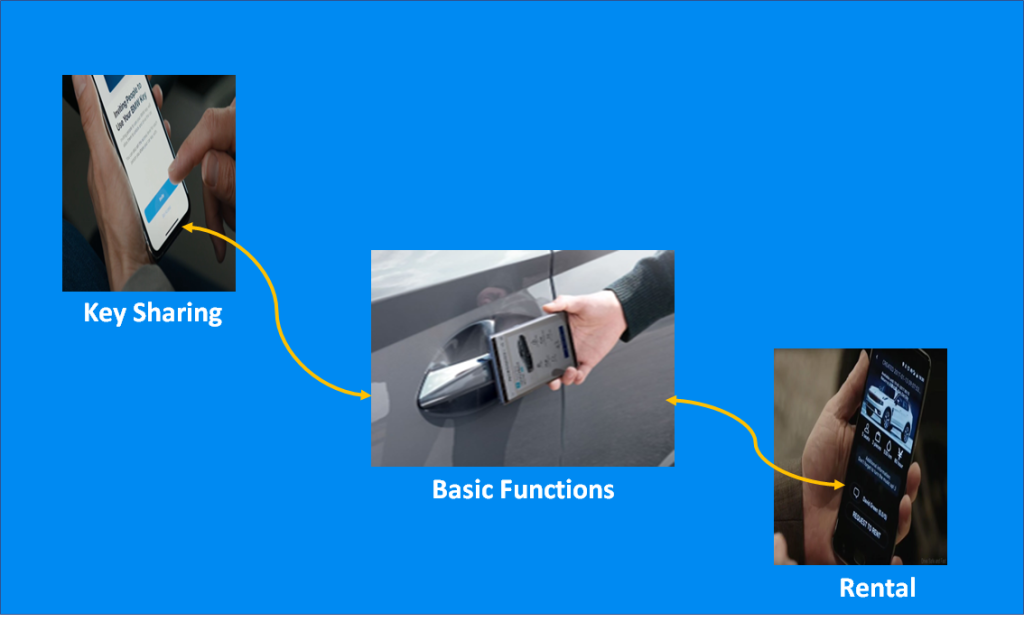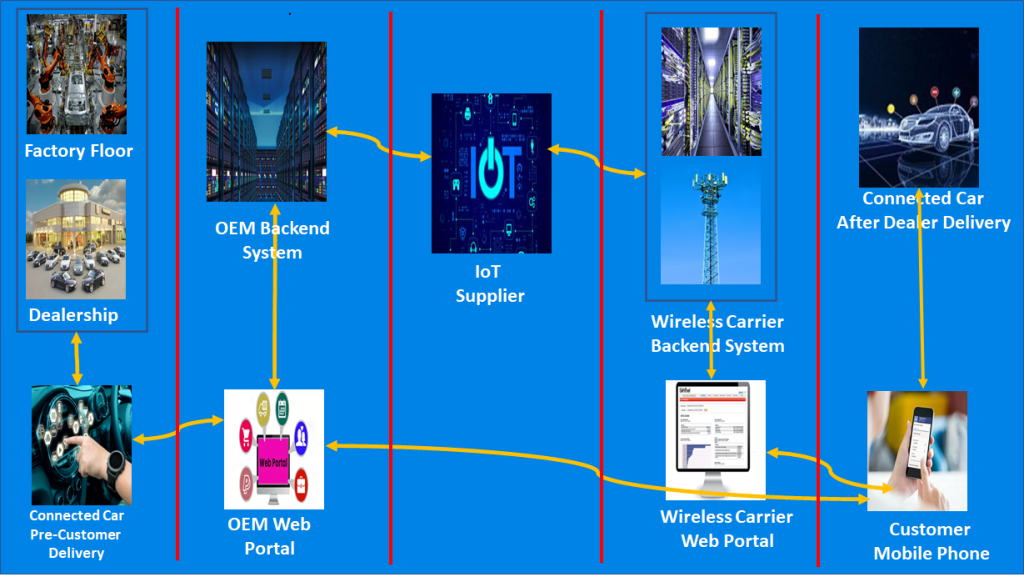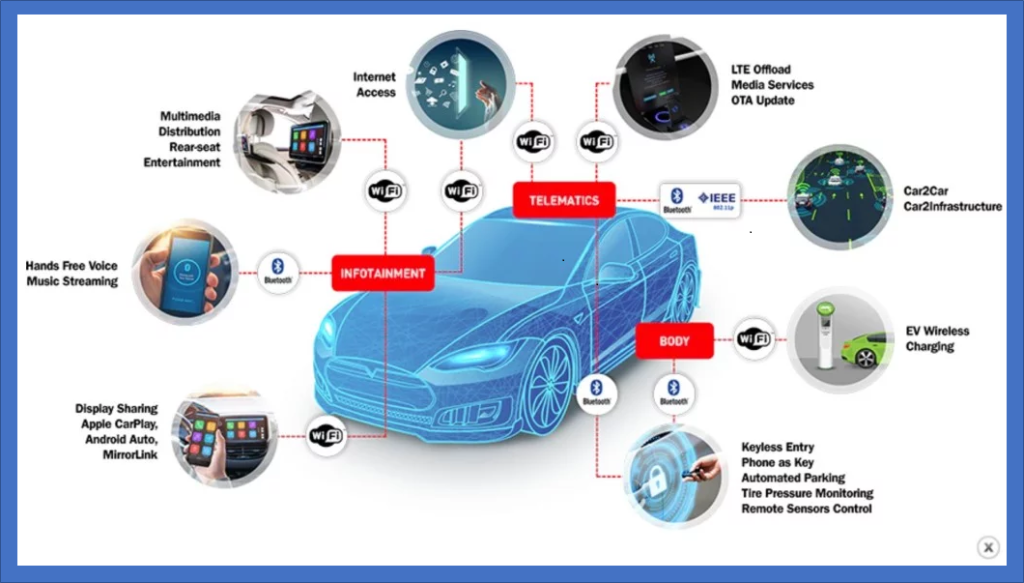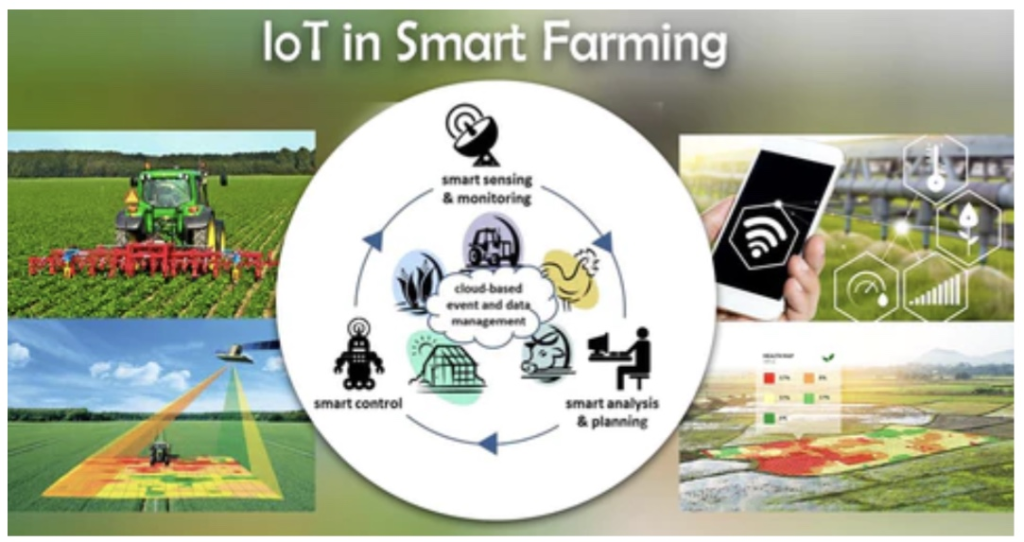This primer will illustrate a few examples about IoT (Internet of Things) and Connected Cars technologies in plain English. It is not a technical but informational sharing blog, hopefully a little entertaining and knowledge enhancing about these rapidly expanding technologies that are now becoming an integral way of life in the modern society.
1.0 Introduction to IoT (Internet of Things)
IoT facilitates communication between physical Things without human interaction. You must have heard and may already be using apps for smart refrigerators, smart lights, smart temperature controls etc. All interactions between refrigerators, lights and temperature controls happen between them and your smart phone. Yes, you must enable communication between those Things by downloading and configuring apps on your smart phone and then the magic happens. Let’s look at an example to make it real. One of the examples is to program your refrigerator in such a way that when certain items, such as cucumbers, eggs, peppers, tomatoes etc. are at a low quantity (it can be set at certain thresholds like 1, 2, 3 or whatever). When your refrigerator’s sensor comes across those thresholds, it sends a text to your smart phone reminding that you are low on certain inventory items (reminders can be limited to 1,2, 3 etc. If something goes wrong with reminder functions and they don’t stop, it is envisioned that one can ask Siri to tell the refrigerator to stop nagging you. Well! that is a nice thought, but there are real entities in life that one has no power to stop them from nagging. Oops!!! sorry for the little diversion here). It may not be a big deal to manage day-to-day household inventory, but it is hugely beneficial for large warehouses or restaurant operators. Major retail stores (e.g., Amazon, Walmart, Costco etc.), utilize this technology to keep track of inventory on the shelves and the back-office supply chain systems (such as SAP, Oracle etc.) trigger purchasing orders fulfillment, logistics, financial transactions for items that surpass lower thresholds to replenish lower inventory items on the shelves.
Below are a couple of easily related examples of IoT devices:

2.0 Introduction to Connected Cars
Most of you must have experience with Connected cars apps already. Connected Cars means that they are connected with internet and the Vehicle Owner’s Smart Phone (we will reference a Vehicle Owner as a customer going forward). Customers can perform certain functions remotely with their mobile app such as: Start / Stop, Lock / Unlock, Climate Controls, Vehicle Status Check, Find My Car Location, Tire Pressure Information, Digital Car Key etc.
The above features have been there for a while and new features are getting introduced, day-by- day by the Original Equipment Manufacturers (OEMs) like GM, Ford, Volkswagen, Tesla etc. In addition to the basic driver functions, Connected Cars can communicate with a host of business and commercial applications (such as insurance, medical emergency, traffic alerts etc.).
One of the interesting applications is Digital Car Key that is worth exploring more.

2.1 Digital Car Key (DCK)
DCK solution replaces the physical key fob with a Smart Phone. Customer can perform all the routine functions with Smart Phone, share digital key (with family and friends, repair shops, transportation companies) without handing over the physical key fob. Vehicle borrowers download digital key on their Smart Phone and drive off with the vehicle. Rental agencies have started to adopt this solution where a rental customer downloads a digital key and drives off rental vehicle from the lot, without dealing with long queues at the rental office (this is becoming very annoying because one may have to endure up to and above 3 hours of wait in the rental office to complete the paper-work).

Some OEMs have introduced a nice customer experience that when a customer is unable to open the doors or start vehicle while away from home, office, hotel etc., they call the OEM’s customer service and their service associates then dispatch an e-taxi service like Uber, Lyft etc. to drive the customer to their destination (now that is an excellent customer experience).
3.0 The Technology Behind Connected Cars
The telematics and remote functions in a vehicle are made functional by an eSIM card (it is a semiconductor chip) just like in a mobile phone (majority of the modern vehicles have an eSIM card and an associated phone number). eSIM is inserted in a hardware module called TCU (Telematics Communication Unit). eSIM enables communication between the vehicle and the Wireless Carriers like AT&T, T-Mobile and Verizon AT&T in US, and Rogers in Canada. TCU has other chips that communicate with various vehicle systems like doors, engine, tires, temperature control etc. to transmit data from those systems to the eSIM so that customer can Interact with their vehicle with a smart phone (sorry no potato chips there, so don’t open your car’s TCU to look for them when driving on a long drive and feeling hungry! just kidding!!! just to let you know that I do think about funny things at times, contrary to the universal belief).
3.1 Connected Car Communication Prior to Dealer Delivery
Typically, when a vehicle is assembled at an OEM factory, Connected Car functions between TCU/eSIM are tested with a default Wireless Carrier for all their vehicles regardless of wherever they are built in the world. When a vehicle is assigned to a country dealer market, the Wireless Carrier get switched to country-based service providers (e.g., AT&T, T-Mobile or Verizon for US, Rogers for Canada, Vodafone and other providers in Europe and rest of the world).
Communication from eSIM to Wireless Carrier is depicted below:
eSIM <-> OEM Backend System <-> IoT Supplier Platform <-> Wireless Carrier Backend System
Managing communication with a vehicle’s eSIM and Wireless Carrier (your smart phone service carrier) is an IoT function in the Connected Car technology space. I work for an IoT services company that provides solutions to several automotive and agricultural OEMs. I am assigned to my company’s OEM customers to ensure that our services are delivered seamlessly.

Complex processes and algorithms run behind the scenes to facilitate the real-time communication between the vehicle, IoT and Wireless Carriers systems. Initially, when communication is enabled between the vehicle and default Wireless Carrier, vehicle profile (VIN, SIM id, assigned phone number etc.) is downloaded in IoT supplier’s platform. When a vehicle is assigned to a specific dealer territory, a process called Localization kicks in to switch from default to country-based Wireless Carriers. Several processes take place to complete localization successfully. Due to a number of variables and failure points, this process creates great challenges for IoT suppliers After localization is completed successfully i.e., the communication between the vehicle and Wireless Carrier is established, a green light in the vehicle’s customer interface indicates all systems go. If the green light does not happen, then typically dealers swap the original TCU with a new one (it is called garage swap). These types of issues are taken very seriously by the OEMs because it could impact customer experience in a negative way (can you imagine that you are sitting in the dealership lobby waiting for your vehicle delivery and the green light does not materialize?). The other issue is monetary impact to the OEM because if a garage swap must happen, it becomes a warranty claim and the OEM gets hit with those claims. OEMs Connected Car organization (these folks are the direct customers for IoT suppliers like my company) managers performance can get hit if things go south and ultimately our customers spread their pain to the service providers. In those situations, we get lectured and sometimes get yelled at.
3.2 Connected Car and the Customer Experience
Ok, let’s pick up our new shining vehicle from the dealership. Customer must download connected car app (OnStar, Car-Net, Tesla App etc.) to register with OEM’s backend system in order to enable the connected car experience. The basic vehicle interactions like open/close doors, start/stop, HVAC, and telematics are functional at this point. These services are labeled as B2B (business to business); meaning all transactions between OEM, IoT supplier and the Wireless Carrier are managed and paid for between these entities. Customer has the ability to make changes to the plans by interacting with OEM and/or Wireless Carrier’s Web Portals.
OEMs offer WiFi services for the vehicle itself i.e., your vehicle can have direct internet connection. Some of the OEMs offer one-month free WiFi subscription (some luxury brands offer six months, and it varies across the spectrum among scores of OEMs). Customer must initiate a purchase transaction to enable the WiFi trial plan. These services are labeled as B2C (Business to Customer), meaning that transactions are managed by the OEM and their suppliers (IoT and Wireless Carrier) and the customer. B2C subscriptions are purchased and paid by the customer.
Major components of Connected Car services can be grouped in the following categories with few examples:
Body (basic car functions)
- Start/Stop
- Open/Close Doors
- Tire pressure monitoring
- Digital Car Key
Infotainment
- Music streaming (Spotify, Apple Music, Alexa etc.)
- Rear seat entertainment (Netflix, Hulu, Amazon Prime Video etc.)
Telematics
- Apple/Android Car play
- Vehicle health alerts
- Internet Access (voice and SMS text)
- Automated software upgrades

When the B2C trial plan ends, customer has the option to purchase a long-term subscription where you pay base monthly charges and data over usage (just like mobile phone services). Other option is to roll your vehicle WiFi services into your personal/family mobile service. Customers also have the option to change Wireless Carrier e.g., from T-Mobile to Verizon and vice versa (sorry Canadian friends, you are stuck with Rogers for the time). This transaction is called Carrier of Choice and it has its own nuances that IoT suppliers must deal in the background.
3.3 Wakeup SMS (Vehicle Texting) Example
One of the interesting applications of texting is called Wakeup SMS. Remember the good old TCU? It goes into sleep mode after some idle days and the customer cannot perform any of the Connected Car functions, until the TCU is awakened from its slumber. Suppose you are in Michigan in the middle of winter, and you want to start your vehicle and warm it up before driving. Since our friend TCU is having some ZZ’s, you must send a text message to wake him up so that you can start the vehicle and get it warmed up by the time you lumber through the heavy snow, sleet, and other elements of winter. TCU goes to sleep based on the idle time set by OEMs and it is not based on the local weather cycle (although winter and sizzling summer days seem logical, but it’s sleep is based on the technical requirements). If the TCU goes into sleep during the dog days of summer, and you want your vehicle to be nice and cool before driving it, so you give a nudge to your vehicle’s TCU to wake up and be on duty.
4.0 IoT and Connected Machinery in the Agriculture Sector
Farming was dependent on human labor from the beginning of civilization to about 12,000 years ago when animals got domesticated and used for farming. Agriculture mechanization started in the
mid-20th century and now this sector is at the forefront of digital transformation.
IoT and Connected Farm Machinery technologies are the same as described in Section 2.0. Communication between the Connected tractors, harvesting machines, transportation devices etc. is managed through OEM’s backend systems, IoT suppliers and the regional Wireless Carries. It is absolutely necessary that farm machinery is ready and functional for farming cycles such as preparing the soil for seeding/watering, and harvesting, among others.
Some of the big farming machinery OEMs taking the lead in digital transportation include CNHi, John Deere and Kubota to name a few.



5.0 Closing
Dear reader, if you have been reading along and made it to this point, congratulations. Now you know the basic functions of IoT and Connected Car technologies and what role they play in our lives. Next time you go to a party, you can enthrall your audience with this knowledge.

